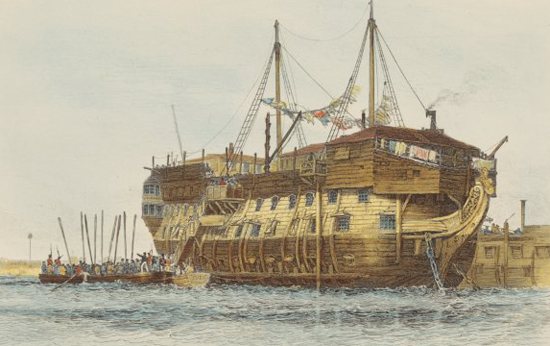Ancestry.co.uk continues to expand their collection, and have now added the UK Prison Hulk Registers and Letter Books 1802-1849 to their collection of online data.
A fascinating collection, this consists of registers and letter books of prisoners on convict prison hulks in England between 1802-1849. A hulk is a decommissioned ship that is either technologically out of date or cannot make it through the open sea without taking on water, but is still able to float without problems. There were many of these ships available when engines started to power ships instead of sails, so the hulks were moored in harbors and used as floating prisons or for other purposes.
The hulks’ place in harbors also made it easier to hold and transport convicts being sent to Australia. The first prison hulks in England appeared after a 1776 act allowed them to be used to house prisoners.
The collection contains a letter book relating to the establishment of hulks written from 1847-1849 and the registers of prisoners on 19 different hulks between 1802-1849 – a total of about 200,000 records. Those covered are: Bellerophon, Captivity, Coromandel, Cumberland, Discovery, Dolphin, Establishment, Euryalus, Fortitude, Ganymede, Hardy, Justitia, Laurel, Leviathan, Perseus, Portland, Prudentia, Retribution, Warrior, and York (pictured).
The records reveal the lives of the convicts who were imprisoned on these hulks and detail each inmate’s name, year of birth, age, year and place of conviction, offence committed, name of the hulk and, most interestingly, character reports written by the ‘gaoler’ (prison officer) which provide intriguing insight into each convict’s personality.
Many of the 200,000 convicts held on board the floating prisons were awaiting transportation to Australia, but the hulks were unable to go to sea, having been stripped of their masts, rigging and rudders, and instead fitted with prison cells.
Typically, each hulk held between 200 and 300 convicts in dire conditions. Disease was rife and spread quickly as there was no way to separate the sick from the healthy in the cramped conditions. This meant mortality rates were high, with around one in three inmates dying on board.
The records will be of use to family and social historians, and anyone with an interest in the UK penal system. They detail the rather bleak conditions that those who fell foul of the law would have found themselves in.











Hello
Can you please tell me where I might find employment records for the “warrior” hulk vessel. I have a relative who was a steward on the above vessel and am looking for any information regarding this. He was a steward around 1851
thanking you.
Louise
Could you please tell me where I can find some information about male convicts who were accommodated on the Irish prison hulk Essex, prior to their departure to Sydney on the convict ship Waterloo 2 in 1830
Thank you,
Tony
Hello, I too am searching for any available information regarding male convicts held onboard the Irish hulk Essex. Departed 1833 onboard HMS Royal Admiral bound for NSW. Any thoughts are greatly appreciated.
Thank you, Seamus
RON KNOX
Hi I am seeking information on William Knox who was on Retribution in 1817, before being transported to Van Dieman’s land. Had been sentenced to 7 years for burglary at Worcester Assizes on 27 July, 1816. Left on the Almorah 28 April 1817.
Hope you can assist.
Ron
Hi, hoping you can hep with information on where convicts sentenced to life at York Assizes, 1 Aug 1829, transported to VDL on Bussorah Merchant, Oct 1829 would be held, as in which hulk. I am researching James Wood, who was 16 when sentenced. He arrived January 1830 VDL.
Hi Susan,
You may have to go to the British Prison Records to find which hulk your ancestor was taken to.
England & Wales, Crime, Prisons & Punishment, 1770-1935 (NA London)
HO 13 Source: Correspondence & Warrants (they essentially record when and to where the prisoner is taken from which jail and to which hulk and when).
If you have access to Findmypast. you will find these correspondences under
Category: Institutions & Organisations
Sub-category: Prison Registers GB
Hope this helps
I am searching information on the Perseus where my ancestor was held whilst waiting transportation to /australia in 1816/ His name is James Chilvers and if I could get a photo of the Perseus for an assignment I am doing with the Uni of Tasmania it would be great.
Hi
John Berry (Bery) was onboard Ganymede from about September 1838 until the Ganymede was broken up later that year. He wasn’t deported until 12th May 1839 onboard Parkfield. How can I find where he was hed afrer Ganymede was broken up.
Thanks
Hi David, For records relating to to prison hulks, I’d start by checking out what TNA has (www.nationalarchives.gov.uk/)
Would like to subscribe please. Not allowing me
I am trying to find out about George Robertson who either arrived on the Susan 1833 or Ephingstone 1834 he was b Edinburgh approx. 1815. He was known as George Robinson in VDl. As I cannot find any record or if he was kept on the Prison Hulks & which one. any help would be appreciated
thank You.
June Robinson
I am trying to find James Privett on a hulk
I am searching for any records relating to the sentencing of my ancestor Edward Sharpe on hulk Justitia and transported to VDL on Claudine 1821
looking for james williams 1514-1575 any info please
Do you know where I may obtain a photo of the prison hulk HMS Fortitude ?